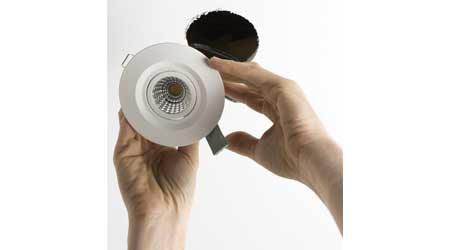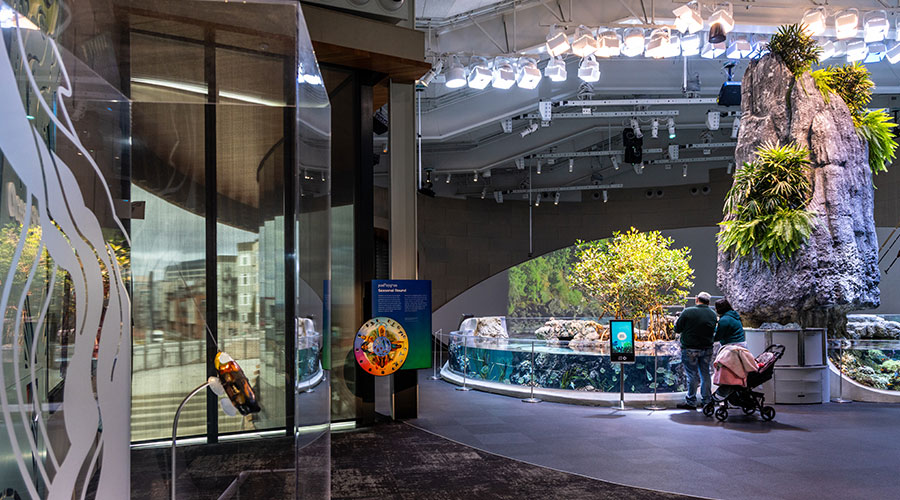LED Issues Include Color Temperature, Light Distribution
Part 2 of a 3-part article on how to evaluate and implement LED light sources
Color temperature, light distribution, aesthetics, and serviceability are additional issues to consider in evaluating LEDs. Here is a closer look at each.
Color temperature meets norms from warm to cool. Today’s LED technology also meets users’ color temperature norms based on their experience with legacy light sources. As measured in degrees Kelvin, LED light sources range from “warm” (2500-3000K) to “cool,” “blue,” or “natural daylight” (5000K and above). For example, a color temperature of 2300K provides the very warm light that is appropriate for residential, retail, or hospitality projects, while 3500K provides the very cool white light that is appropriate for commercial office spaces.
Unlike fluorescent light sources, which never adequately matched the warm color of incandescents, LEDs are also an energy-efficient alternative to incandescents where warm light is desirable.
Light distribution achieves diffuse objective. As a point-source light, LEDs were used in the past to create directional downlighting, accent lighting, and spot lighting. Today, there are a wide range of LED light fixtures that use reflectors and lenses to diffuse light, enabling LEDs to be used for ambient lighting that is appropriate in many commercial applications, including offices. The task-ambient lighting designs for these environments may combine task lighting at the desks with pendant-indirect or recessed 2-by-4-foot fixtures providing indirect ambient light.
Appearance goes sophisticated, high-tech. Until recently, the majority of LED fixtures were designed to replicate legacy fixtures, such as 2-by-4-foot recessed light fixtures that fit into ceiling tiles. It has been a challenge to use highly designed, decorative light fixtures in commercial applications, including hospitality and high-tech spaces, because they required incandescent light sources. The new, smaller LED modules and fixtures are an energy-efficient alternative.
For example, LED technology was used for creative, high-tech lighting designs for the tenant interiors of a Seattle-based global online retailer. (See “LED Delivered High Level of Design, Performance for Online Retailer” in Part 3 of this article.)
Serviceability, replacement require new management approach. Unlike legacy light sources, LED light sources do not flicker or suddenly “burn out.” As an LED light source approaches the end of its life-cycle, it will gradually provide less light. To maintain optimal lighting, facility managers should implement a long-term management process, including a record of LED module/fixture serial numbers and installation dates and a replacement schedule based on projected lamp life.
Similarly, facility managers should change their replacement process. Unlike halogen lamps or compact fluorescent light (CFL) bulbs, commercial LED modules are typically hard-wired into the fixture. The higher quality LED fixtures use a quick-connect component to connect the module to the fixture for ease of replacement, while others are more difficult to replace. Facility managers, lighting designers, and other specifiers should keep this issue in mind when selecting LED products.
In either case, the facility manager should contact the LED manufacturer and provide the serial number of the old LED module or fixture to obtain an appropriate replacement with the same lumen output as the module that was originally specified. The old LED module/fixture is typically returned to the manufacturer for recycling of the components.
That said, the industry is manufacturing relatively inexpensive utilitarian fixtures, such as garage light fixtures, that are meant to be thrown away and replaced at the end of their useful lives. Some larger facilities are beginning to use these to lower maintenance costs.
In some cases, a facility manager may be ready to renovate the entire space or upgrade its lighting system to the next generation of LED lighting at 50,000 hours.
Related Topics:














